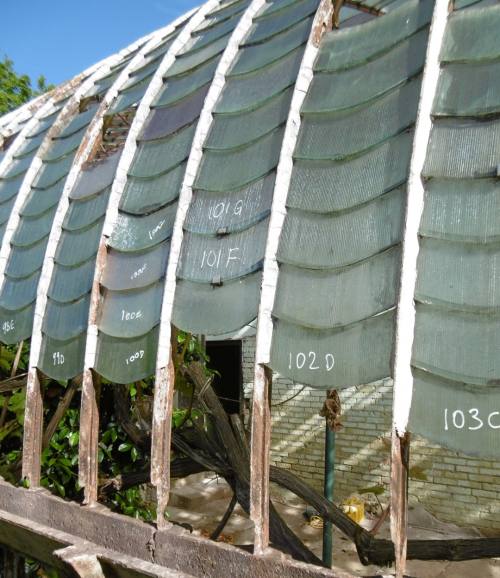Restoration
1st Update: 7th June 2015
The contractors have now completed the first two of their 22 week programme. The greenhouse already looks very different. Four steps have been carried out.
- The east and west gables have been completely deglazed and in the east gable the unsightly wooden doors inserted in the 1950s to allow for the inside parking of garden machinery have been removed. It is intended that both gables be reglazed with new, “drawn”, clear, fishscale glass. All thin-reeded glass will be saved for reuse in the roof.
Findings: We were all struck by how slender and graceful the vertical glazing bars are when fully exposed. Despite being nearly 200 years old, they are in very good condition. That said with the glass removed they wobble- it is the glass that puts the building under tension – and on the (weaker) east gable the verticals are now braced.
- The two lowest layers of glass on the roof have been numbered for reuse and removed. This is to allow close inspection of the places where the roof glazing bars are attached to the cast iron casements. The inside of the casement has a small pot into which the lower end of the bar was sunk and then had molten lead poured round it. How molten lead came to be produced in a garden in 1830 is a mystery.
Findings: As we knew, it is these joints that have suffered the greatest corrosion from internal condensation. Approximately 25% of the bars will be cut away at the bottom and a new piece of identical pattern welded in. In some cases it may be necessary to go further, dig out the lead fastening and then re-lead the new foot. As this requires heat, it is quite an undertaking and will only be done where essential.
Approximately 25% of the bars will be cut away at the bottom and a new piece of identical pattern welded in. In some cases it may be necessary to go further, dig out the lead fastening and then re-lead the new foot. As this requires heat, it is quite an undertaking and will only be done where essential.
- The casement windows have been de-glazed. They were a very unsightly mix of reeded, fishscale and square, plain glass. The reeded glass has again been saved for reuse. These windows will be send to Calibre’s plant in Stockport to be thoroughly cleaned and treated.
Findings: We suspected that the west side of the greenhouse was built some time after the east side. However once we come to look closely at the prefabricated components such as casement frames and stays, all sorts of tiny design differences emerge between the two halves. These we shall be noting as we go along.
- Having decided not to undertake a full deglazing, there has been a concern that it would not be possible properly to clean the very narrow spaces where the fishscale panes overlap and where dirt and some sort of algae has accumulated over the years. This has caused significant discoloration. Calibre has now done a test clean of some 30 panes with a combination of water jets and dental brushes.
Findings: A remarkable success.






